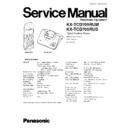Panasonic KX-TCD705RUM / KX-TCD705RUS Service Manual ▷ View online
7.6. CHARGE CURRENT TESTS
7.5. TELEPHONE LINE TESTS
1. Switch on the 9V power supply.
2. Connect a telephone cord from the base unit to the line/DTMF test set.
3. Enter "HOOKOFF" from the PC to invoke an off-hook condition.
4. Set the current limit to 40mA on the line simulator.
5. Enter "HOOKON" from the PC to invoke the on-hook condition.
6. Check that the line current has dropped to 0 ± 0.5mA.
7. Enter "HOOKOFF".
8. Use a DMM to test the off-hook voltage at TP50. It must be 6.0V ± 1.0V.
9. Enter "LINEIMP 1" at the PC to switch on the pulse-dialing impedance.
10. Check the DC voltage at TP50. It must be < 3.5V.
11. Enter "LINEIMP 0" at the PC to switch off the pulse-dialing impedance.
12. Enter "DTMF_UP" to make the base generate the upper DTMF frequency.
13. Check that the upper frequency is detected by the line/DTMF test set. Must be 1477Hz ± 1.5%.
14. Enter "DTMF_LO" to make the base generate the lower DTMF frequency.
15. Check that the lower frequency is detected by the line/DTMF test set. Must be 852Hz ± 1.5%.
16. Switch off the 9V power supply.
17. Disconnect the telephone line and reconnect the base to the Bell oscillator.
18. Switch on the 9V supply.
19. Enter "RINGDET" to check the ring detection status. The command returns a number to the PC display. "0" = no ring.
20. Switch the bell oscillator on to 23Hz, 30V RMS.
21. Send the batch file "RINGDET".
22. Check that the Number on the PC display has changed to "1".
23. Switch off the 9V power supply.
1. Switch on the 9V power supply.
2. Connect an ammeter directly across the charge terminals (effectively short circuiting them).
3. Measure 270mA ± 15% through the meter.
4. Switch off the 9V power supply.
33
KX-TCD705RUM / KX-TCD705RUS
8 CHECK PROCEDURE (HANDSET)
8.1. EQUIPMENT REQUIRED
8.2. INITIAL POWER TESTS
1. Switch on the 2.4V supply.
2. Switch the handset on at the keypad.
3. Check for approx. 120mA current on the supply line for around 10s.
4. Check the 3.8V supply rail at TP11. It must be 3.8V ± 0.2V.
5. Check the 2.65V supply rail at the collector of transistor T6. It must be 2.65V ± 0.2V.
6. Switch off the 2.4V supply.
34
KX-TCD705RUM / KX-TCD705RUS
8.3. SET CLOCK FREQUENCY
1. Turn on the 2.4V supply.
2. Switch the handset on at the keypad.
3. Enter "DEACTMAC" from the PC to switch off the RF unit.
4. Enter "CONTTX 0" to start continuous RF transmission.
5. Check that the current consumption is approx. 220mA.
6. Enter "RDEEPROM 00 00 02" to display the two-byte frequency adjustment value, MSB first.
7. Connect the frequency counter probe to TP24 to measure the SYRI signal from the BBIC.
8. The clock frequency should be within 10,368,000Hz ± 10Hz. If not then enter "SETFREQ nn nn" where nn nn are the clock
frequency adjustment values. An increase in the value will lower the clock frequency and vice versa. The maximum value is 01
FF.
FF.
9. Switch off the 2.4V supply.
8.4. LOOPBACK TESTS
1. Connect the RF input cable from the CMD60 to the "0V" and "ANT" antenna pads.
2. Switch on the 2.4V supply.
3. Switch the handset on at the keypad.
4. Enter "RDEEPROM 00 4A 01". This will return the value "25" if a base has been registered to the handset, or "FF" if there is
no base registered.
5. If a base is not registered to the unit (i.e. "FF" returned in step 4) then enter "SETBASE" to induce registration.
6. Set the CMD60 to MANUAL TEST mode.
7. Enter "TESTMODE" on the PC.
8. Enter "RDEEPROM 00 36 05" to obtain the base RFPI identifier.
9. Set the RFPI in the CMD60 to the value obtained in the previous step.
10. Press SETUP CONNECT on the CMD60.
11. Check the power (NTP): it must be between 20 and 25dBm.
12. Press MODULATION.
13. Set DATA TYPE to FIG 31.
14. Check frequency drift: must be 0 ± 35 kHz/ms.
15. Check frequency offset: must be 0 ± 40 kHz.
16. Check deviation or modulation (max ± B field) with data type "FIG 31": must be 320kHz to 400kHz.
17. Press Menu Up "
↑
" on the CMD60.
18. Press POWER RAMP.
19. Check that the burst fits the mask.
20. Press Menu Up "
↑
" on the CMD60.
21. Press BER.
22. Obtain the sensitivity by slowly reducing RF LEVEL until the BER falls below 1000ppm. The sensitivity is the RF LEVEL reading
at this point. It must be < -88dBm.
23. Press Menu Up "
↑
" on the CMD60.
24. Press BEARER RELEASE and switch off the 2.4V supply.
25. If the "SETBASE" operation above was carried out then enter "RESBASE" to de-register.
26. Disconnect the RF cable.
Note:
Step 2 to 24 can be repeated for TRAFFIC CARRIERS 0 and 9.
35
KX-TCD705RUM / KX-TCD705RUS
9 TROUBLESHOOTING GUIDE
9.1. HANDSET: DOES NOT OPERATE
36
KX-TCD705RUM / KX-TCD705RUS
Click on the first or last page to see other KX-TCD705RUM / KX-TCD705RUS service manuals if exist.

